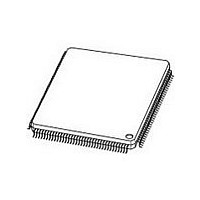LPC2214FBD144 NXP Semiconductors, LPC2214FBD144 Datasheet - Page 24

LPC2214FBD144
Manufacturer Part Number
LPC2214FBD144
Description
Manufacturer
NXP Semiconductors
Datasheet
1.LPC2214FBD144.pdf
(45 pages)
Specifications of LPC2214FBD144
Cpu Family
LPC2000
Device Core
ARM7TDMI-S
Device Core Size
16/32Bit
Frequency (max)
60MHz
Interface Type
I2C/SPI
Program Memory Type
Flash
Program Memory Size
256KB
Total Internal Ram Size
16KB
# I/os (max)
112
Number Of Timers - General Purpose
2
Operating Supply Voltage (typ)
1.8/3.3V
Operating Supply Voltage (max)
1.95/3.6V
Operating Supply Voltage (min)
1.65/2.5/3V
On-chip Adc
8-chx10-bit
Instruction Set Architecture
RISC
Operating Temp Range
-40C to 85C
Operating Temperature Classification
Industrial
Mounting
Surface Mount
Pin Count
144
Package Type
LQFP
Lead Free Status / Rohs Status
Compliant
Available stocks
Company
Part Number
Manufacturer
Quantity
Price
Part Number:
LPC2214FBD144
Manufacturer:
NXP
Quantity:
20 000
Company:
Part Number:
LPC2214FBD144,551
Manufacturer:
NXP Semiconductors
Quantity:
10 000
Company:
Part Number:
LPC2214FBD144/01
Manufacturer:
LT
Quantity:
3 400
Company:
Part Number:
LPC2214FBD144/01
Manufacturer:
NXP
Quantity:
5 000
Part Number:
LPC2214FBD144/01
Manufacturer:
NXP/恩智浦
Quantity:
20 000
Company:
Part Number:
LPC2214FBD144/01,5
Manufacturer:
Intersil
Quantity:
637
Company:
Part Number:
LPC2214FBD144/01,5
Manufacturer:
NXP Semiconductors
Quantity:
10 000
Part Number:
LPC2214FBD144/01,5
Manufacturer:
NXP/恩智浦
Quantity:
20 000
Company:
Part Number:
LPC2214FBD144/015
Manufacturer:
NXP Semiconductors
Quantity:
135
NXP Semiconductors
LPC2212_2214_4
Product data sheet
6.18.6 Memory mapping control
6.18.7 Power control
6.18.8 APB
6.19.1 EmbeddedICE
6.19 Emulation and debugging
The Memory Mapping Control alters the mapping of the interrupt vectors that appear
beginning at address 0x0000 0000. Vectors may be mapped to the bottom of the on-chip
flash memory, or to the on-chip static RAM. This allows code running in different memory
spaces to have control of the interrupts.
The LPC2212/2214 support two reduced power modes: Idle mode and Power-down
mode. In Idle mode, execution of instructions is suspended until either a Reset or interrupt
occurs. Peripheral functions continue operation during Idle mode and may generate
interrupts to cause the processor to resume execution. Idle mode eliminates power used
by the processor itself, memory systems and related controllers, and internal buses.
In Power-down mode, the oscillator is shut down and the chip receives no internal clocks.
The processor state and registers, peripheral registers, and internal SRAM values are
preserved throughout Power-down mode and the logic levels of chip output pins remain
static. The Power-down mode can be terminated and normal operation resumed by either
a Reset or certain specific interrupts that are able to function without clocks. Since all
dynamic operation of the chip is suspended, Power-down mode reduces chip power
consumption to nearly zero.
A Power Control for Peripherals feature allows individual peripherals to be turned off if
they are not needed in the application, resulting in additional power savings.
The APB divider determines the relationship between the processor clock (CCLK) and the
clock used by peripheral devices (PCLK). The APB divider serves two purposes. The first
is to provide peripherals with the desired PCLK via APB so that they can operate at the
speed chosen for the ARM processor. In order to achieve this, the APB may be slowed
down to
power-up (and its timing cannot be altered if it does not work since the APB divider control
registers reside on the APB), the default condition at reset is for the APB to run at
processor clock rate. The second purpose of the APB divider is to allow power savings
when an application does not require any peripherals to run at the full processor rate.
Because the APB divider is connected to the PLL output, the PLL remains active (if it was
running) during Idle mode.
The LPC2212/2214 support emulation and debugging via a JTAG serial port. A trace port
allows tracing program execution. Debugging and trace functions are multiplexed only with
GPIOs on Port 1. This means that all communication, timer and interface peripherals
residing on Port 0 are available during the development and debugging phase as they are
when the application is run in the embedded system itself.
Standard ARM EmbeddedICE logic provides on-chip debug support. The debugging of
the target system requires a host computer running the debugger software and an
EmbeddedICE protocol convertor. EmbeddedICE protocol convertor converts the Remote
Debug Protocol commands to the JTAG data needed to access the ARM core.
1
2
to
1
4
of the processor clock rate. Because the APB bus must work properly at
Rev. 04 — 3 January 2008
16/32-bit ARM microcontrollers
LPC2212/2214
© NXP B.V. 2008. All rights reserved.
1
4
24 of 45
of the
















